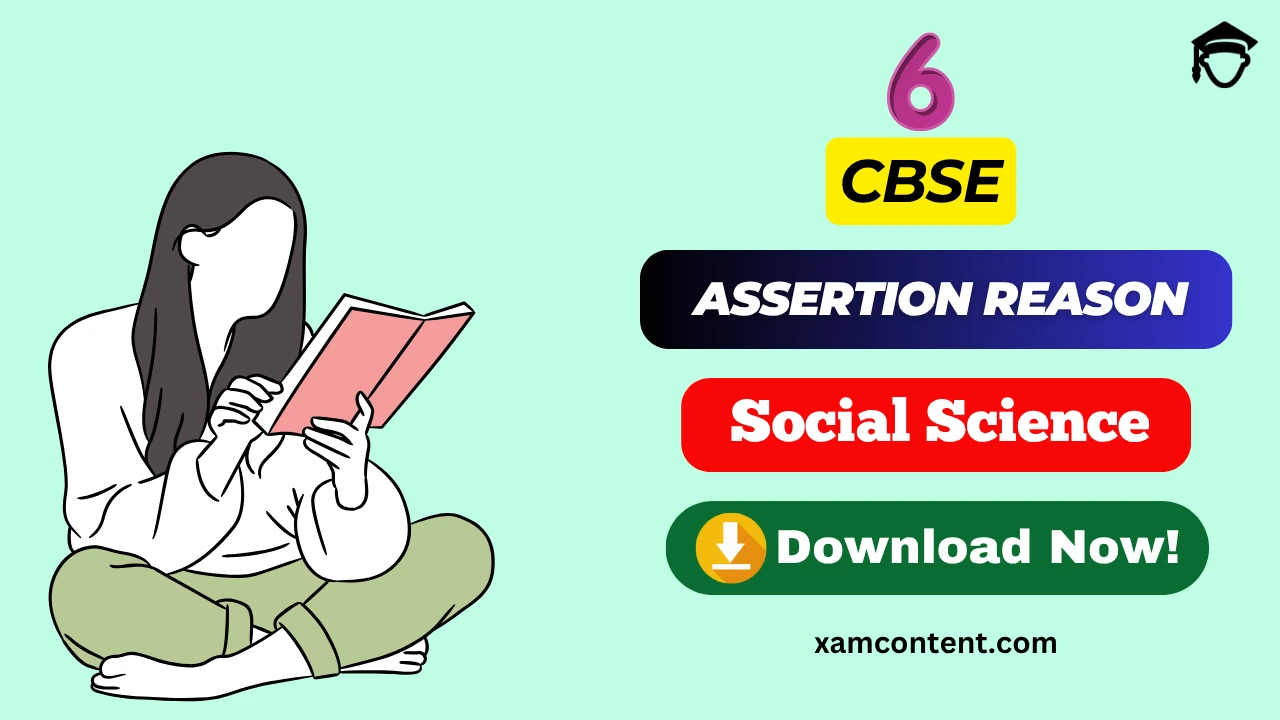Hello students, we are providing assertion reason questions for class 6. Assertion Reason questions are the new question format that is introduced in CBSE board. The resources for assertion reason questions are very less. So, to help students we have created chapterwise assertion reason questions for class 6 Social Science. In this article, you will find assertion reason questions for CBSE Class 6 Social Science Chapter 3 Landforms and Life. It is a part of Assertion Reason Questions for CBSE Class 6 Social Science Series.
| Chapter | Landforms and Life |
| Type of Questions | Assertion Reason Questions |
| Nature of Questions | Competency Based Questions |
| Board | CBSE |
| Class | 9 |
| Subject | Social Science |
| Useful for | Class 6 Studying Students |
| Answers provided | Yes |
| Difficulty level | Mentioned |
| Important Link | Class 6 Social Science Chapterwise Assertion Reason |
Assertion Reason Questions on Landforms and Life
Q1. Assertion (A): Mountains generally have steep slopes and high elevation.
Reason (R): They are formed only by volcanic eruptions.
(a) Both A and R are true and R is the correct explanation of A.
(b) Both A and R are true but R is not the correct explanation of A.
(c) A is true but R is false.
(d) A is false but R is true.
Show Answer
Ans: (c)
Explanation: The assertion is true, but the reason is false. Mountains can form by tectonic plate collision, folding, faulting, and volcanism—not only by volcanoes.
Q2. Assertion (A): Plateaus are elevated flat-topped areas.
Reason (R): The Deccan Plateau is an example of a plateau in India.
(a) Both A and R are true and R is the correct explanation of A.
(b) Both A and R are true but R is not the correct explanation of A.
(c) A is true but R is false.
(d) A is false but R is true.
Show Answer
Ans: (a)
Explanation: Both are true and connected: the Deccan Plateau exemplifies the flat-topped elevated landform known as a plateau.
Q3. Assertion (A): Plains are usually the most suitable for agriculture and settlements.
Reason (R): They are generally formed by river deposits and have fertile soils.
(a) Both A and R are true and R is the correct explanation of A.
(b) Both A and R are true but R is not the correct explanation of A.
(c) A is true but R is false.
(d) A is false but R is true.
Show Answer
Ans: (a)
Explanation: Both statements are true, and the reason explains why plains support dense populations and farming—because of rich alluvial soils.
Q4. Assertion (A): Deserts receive heavy rainfall throughout the year.
Reason (R): Hot deserts typically have sparse vegetation and extreme temperatures.
(a) Both A and R are true and R is the correct explanation of A.
(b) Both A and R are true but R is not the correct explanation of A.
(c) A is true but R is false.
(d) A is false but R is true.
Show Answer
Ans: (d)
Explanation: The reason is true—hot deserts have extreme conditions—but the assertion is false since deserts receive very low rainfall.
Q5. Assertion (A): Rivers shape landforms by erosion, transportation, and deposition.
Reason (R): Deltas are formed at the river’s mouth where it meets a sea or ocean.
(a) Both A and R are true and R is the correct explanation of A.
(b) Both A and R are true but R is not the correct explanation of A.
(c) A is true but R is false.
(d) A is false but R is true.
Show Answer
Ans: (b)
Explanation: Both are true; the reason gives a specific result of deposition but does not fully explain all three processes mentioned in the assertion.
Q6. Assertion (A): Human life adapts to different landforms, influencing clothing, houses, and occupations.
Reason (R): In mountain regions, terrace farming helps to grow crops on steep slopes.
(a) Both A and R are true and R is the correct explanation of A.
(b) Both A and R are true but R is not the correct explanation of A.
(c) A is true but R is false.
(d) A is false but R is true.
Show Answer
Ans: (b)
Explanation: Both statements are true; the reason is a relevant example, but it is not a complete explanation for all the ways landforms affect life.
Q7. Assertion (A): Coastal areas often face risks from cyclones and sea-level changes.
Reason (R): Such regions may also benefit from fishing, ports, and tourism.
(a) Both A and R are true and R is the correct explanation of A.
(b) Both A and R are true but R is not the correct explanation of A.
(c) A is true but R is false.
(d) A is false but R is true.
Show Answer
Ans: (b)
Explanation: Both statements are true; the reason adds benefits of coasts but does not directly explain the hazards mentioned in the assertion.
Q8. Assertion (A): Valleys are high, flat regions with very little slope.
Reason (R): They are typically carved by rivers or glaciers between hills or mountains.
(a) Both A and R are true and R is the correct explanation of A.
(b) Both A and R are true but R is not the correct explanation of A.
(c) A is true but R is false.
(d) A is false but R is true.
Show Answer
Ans: (d)
Explanation: The reason is true—valleys are often river- or glacier-carved—but the assertion is false because valleys are low-lying, not high flat regions.
We hope the given assertion reason questions with Answers for Landforms and Life Class 6 helps you in your learning.

Also check
- Class 6 Social Science Assertion Reason Questions Chapter 10 – Grassroots Democracy Part 1 Governance
- Class 6 Social Science Assertion Reason Questions Chapter 9 – Family and Community
- Class 6 Social Science Assertion Reason Questions Chapter 8 – Unity in Diversity
- Class 6 Social Science Assertion Reason Questions Chapter 7 – India’s Cultural Roots
- Class 6 Social Science Assertion Reason Questions Chapter 6 – The Beginings of Indian Civilisation
- Class 6 Social Science Assertion Reason Questions Chapter 5 – India, that is Bharat
- Class 6 Social Science Assertion Reason Questions Chapter 4 – Timeline and Sources of History
- Class 6 Social Science Assertion Reason Questions Chapter 3 – Landforms and Life
- Class 6 Social Science Assertion Reason Questions Chapter 2 – Ocean and Continents
- Class 6 Social Science Assertion Reason Questions Chapter 1 – Locating Places on Earth
Topics from which assertion reason questions may be asked
[TOPICS]
[QUOTE BLOCK]
Assertion reason questions from the above given topic may be asked.

You may also like

Frequently Asked Questions (FAQs) on Landforms and Life Assertion Reason Questions Class 6
Q1: What are Assertion Reason Questions in Class 6 Social Science?
A1: Assertion Reason Questions are a new type of competency-based questions where students are given two statements — an Assertion (A) and a Reason (R). Students must decide whether each statement is true and whether the Reason correctly explains the Assertion.
Q2: How can Assertion Reason Questions help in exam preparation?
A2: These questions help students think critically, understand cause–effect relationships, and go beyond rote learning. They strengthen conceptual clarity in topics like History, Geography, and Civics by testing logical connections between facts.
Q3: How should students approach Assertion Reason Questions?
A3: Students should first read both statements carefully, identify whether each is true or false, and then check if the Reason actually explains the Assertion. Practicing chapter-wise Assertion Reason sets regularly improves accuracy and speed.
Q4: Are Assertion Reason Questions included in CBSE Class 6 syllabus?
A4: While Assertion Reason Questions are not directly mentioned in the NCERT syllabus, they are part of the new competency-based assessment pattern introduced by CBSE to promote conceptual understanding and analytical thinking.
Q5: What types of topics are covered in Class 6 Social Science Assertion Reason Questions?
A5: Topics include key chapters from History (e.g., What, Where, How and When?), Geography (e.g., The Earth in the Solar System), and Civics (e.g., Understanding Diversity) — focusing on reasoning, relationships, and application of knowledge.
Q6: Where can I find Assertion Reason Questions for Class 6 Social Science Chapter-wise?
A6: You can access free, chapter-wise Assertion Reason Questions with detailed explanations at xamcontent.com and physicsgurukul.com. These resources are designed as per the latest CBSE competency-based exam format.



